
A fossil is any preserved remains, impression, or trace of any once-living thing from a past geological age. Examples include bones, shells, exoskeletons, stone imprints of animals or microbes, objects preserved in amber, hair, petrified wood and DNA remnants. The totality of fossils is known as the fossil record.

Trilobites are extinct marine arthropods that form the class Trilobita. Trilobites form one of the earliest known groups of arthropods. The first appearance of trilobites in the fossil record defines the base of the Atdabanian stage of the Early Cambrian period and they flourished throughout the lower Paleozoic before slipping into a long decline, when, during the Devonian, all trilobite orders except the Proetida died out. The last extant trilobites finally disappeared in the mass extinction at the end of the Permian about 252 million years ago. Trilobites were among the most successful of all early animals, existing in oceans for almost 270 million years, with over 22,000 species having been described.

The lycophytes, when broadly circumscribed, are a group of vascular plants that include the clubmosses. They are sometimes placed in a division Lycopodiophyta or Lycophyta or in a subdivision Lycopodiophytina. They are one of the oldest lineages of extant (living) vascular plants; the group contains extinct plants that have been dated from the Silurian. Lycophytes were some of the dominating plant species of the Carboniferous period, and included the tree-like arboresencent lycophytes, some of which grew over 40 metres (130 ft) in height, although extant lycophytes are relatively small plants.
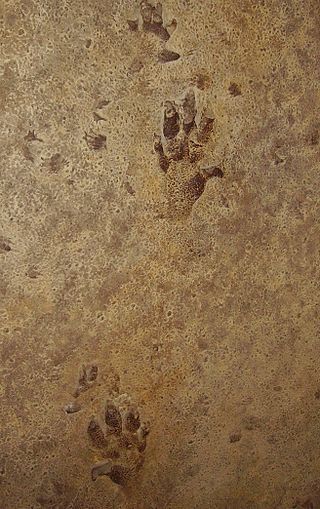
A trace fossil, also known as an ichnofossil, is a fossil record of biological activity but not the preserved remains of the plant or animal itself. Trace fossils contrast with body fossils, which are the fossilized remains of parts of organisms' bodies, usually altered by later chemical activity or mineralization. The study of such trace fossils is ichnology and is the work of ichnologists.
A way up structure, way up criterion, or geopetal indicator is a characteristic relationship observed in a sedimentary or volcanic rock, or sequence of rocks, that makes it possible to determine whether they are the right way up or have been overturned by subsequent deformation. This technique is particularly important in areas affected by thrusting and where there is a lack of other indications of the relative ages of beds within the sequence, such as in the Precambrian where fossils are rare.
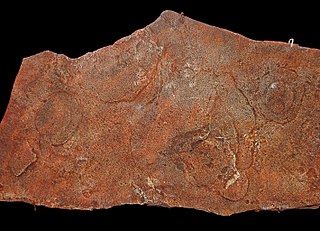
Ediacaria is a fossil genus dating to the Ediacaran Period of the Neoproterozoic Era. Unlike most Ediacaran biota, which disappeared almost entirely from the fossil record at the end of the Period, Ediacaria fossils have been found dating from the Baikalian age of the Upper Riphean to 501 million years ago, well into the Cambrian Period. Ediacaria consists of concentric rough circles, radial lines between the circles and a central dome, with a diameter from 1 to 70 cm.
Trace fossils are classified in various ways for different purposes. Traces can be classified taxonomically, ethologically, and toponomically, that is, according to their relationship to the surrounding sedimentary layers. Except in the rare cases where the original maker of a trace fossil can be identified with confidence, phylogenetic classification of trace fossils is an unreasonable proposition.
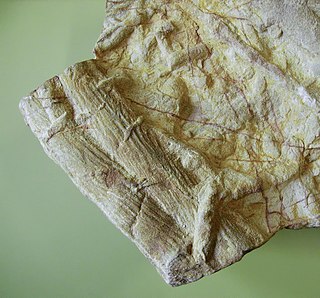
Cruziana is a trace fossil consisting of elongate, bilobed, approximately bilaterally symmetrical burrows, usually preserved along bedding planes, with a sculpture of repeated striations that are mostly oblique to the long dimension. It is found in marine and freshwater sediments. It first appears in upper Fortunian rocks of northern Iran and northern Norway. Cruziana has been extensively studied because it has uses in biostratigraphy, and because the traces can reveal many aspects of their makers' behavior.

Diplichnites are arthropod trackways with two parallel rows of blunt to elongate, closely spaced tracks oriented approximately perpendicularly to the mid-line of the trackway. The term is more often used for the ichnofossils of this description; however, similar trackways from recent arthropods are sometimes given this name as well.
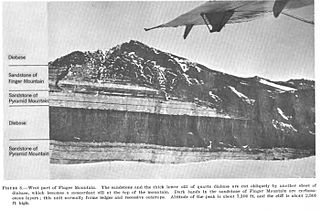
The Beacon Supergroup is a geological formation exposed in Antarctica and deposited from the Devonian to the Triassic. The unit was originally described as either a formation or sandstone, and upgraded to group and supergroup as time passed. It contains a sandy member known as the Beacon Heights Orthoquartzite.

Rusophycus is a trace fossil ichnogenus allied to Cruziana. Rusophycus is the resting trace, recording the outline of the tracemaker; Cruziana is made when the organism moved. The sculpture of Rusophycus may reveal the approximate number of legs that the tracemaker had, although striations (scratchmarks) from a single leg may overlap or be repeated.

The "Cambrian substrate revolution" or "Agronomic revolution", evidenced in trace fossils, is a sudden diversification of animal burrowing during the early Cambrian period.

The Lock Haven Formation is a Devonian mapped bedrock unit in Pennsylvania, in the Appalachian Mountains of the United States.
The Cambrian explosion, Cambrian radiation,Cambrian diversification, or the Biological Big Bang refers to an interval of time approximately 538.8 million years ago in the Cambrian Period when practically all major animal phyla started appearing in the fossil record. It lasted for about 13 – 25 million years and resulted in the divergence of most modern metazoan phyla. The event was accompanied by major diversification in other groups of organisms as well.
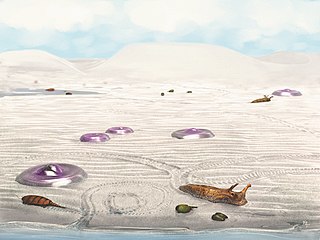
Blackberry Hill is a Konservat-Lagerstätte of Cambrian age located within the Elk Mound Group in Marathon County, Wisconsin. It is found in a series of quarries and outcrops that are notable for their large concentration of exceptionally preserved trace fossils in Cambrian tidal flats. One quarry in particular also has the distinction of preserving some of the first land animals. These are preserved as three-dimensional casts, which is unusual for Cambrian animals that are only lightly biomineralized. Additionally, Blackberry Hill is the first occurrence recognized to include Cambrian mass strandings of scyphozoans (jellyfish).
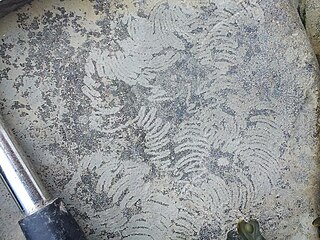
Nereites is a genus of trace fossil. Modern tracemakers of incipient Nereites include worm-like organisms, horseshoe crabs and hermit crabs. Traditionally, two models have been proposed for Nereites:
- in the ‘worm model’, Nereites is a feeding burrow produced by wormlike organisms, probing and backfilling laterally
- in the ‘arthropod model’, the characteristic lobes are pressure-release structures made by arthropod legs. According to this interpretation, Nereites is a locomotion trail

The Random Formation is a rock unit in Newfoundland dating to the early Cambrian period, dominated by tidal quartz arenites deposited in a near-shore environment, but also incorporating intertidal and open-shelf deposits, including glauconitic and mud-cracked mudstones, and red channel sandstones. It was deposited quickly and is approximately 175 m thick. The Blue Pinion Formation was originally recognized as a separate formation, but is now interpreted as an expression of the Random Formation.

The Interim Register of Marine and Nonmarine Genera (IRMNG) is a taxonomic database which attempts to cover published genus names for all domains of life from 1758 in zoology up to the present, arranged in a single, internally consistent taxonomic hierarchy, for the benefit of Biodiversity Informatics initiatives plus general users of biodiversity (taxonomic) information. In addition to containing over 490,000 published genus name instances as at March 2020, the database holds over 1.7 million species names, although this component of the data is not maintained in as current or complete state as the genus-level holdings. IRMNG can be queried online for access to the latest version of the dataset and is also made available as periodic snapshots or data dumps for import/upload into other systems as desired.

The Middleton Formation is a geological formation that extends through the Northern Cape, Western Cape, and Eastern Cape provinces of South Africa. It overlies the lower Abrahamskraal Formation, and is the eastern correlate, East of 24ºE, of the Teekloof Formation. Outcrops and exposures of the Middleton Formation range from Graaff-Reinet in the Eastern Cape onwards. The Middleton Formation's type locality lies near the small hamlet, Middleton, approximately 25 km south of Cookhouse. Other exposures lie in hillsides along the Great Fish River in the Eastern Cape. The Middleton Formation forms part of the Adelaide Subgroup of the Beaufort Group, which itself forms part of the Karoo Supergroup.

















